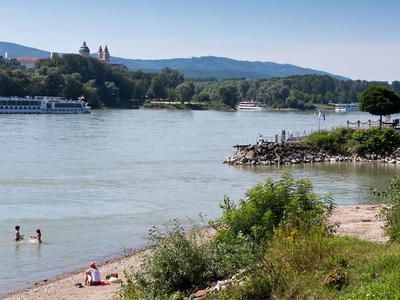The Wachau, a wine growing area renowned throughout the world, begins just where the magnificent baroque Melk Abbey arises on the southern bank. In 2000, the Wachau was declared part of the UNESCO World heritage. The picturesque river valley, in its entirety, extends up to the city of Krems 40 km Downstream.
The Wachau lies on the border of two Lower Austrian landscapes, Mostviertel to the south and Waldviertel to the north. The landscape is a combination of the river and near-shore areas with favourable climate and the adjacent hills of the Waldviertel region (altitudes up to 900 m) with cold winters. These climate conditions favor fruit production, like the famous Wachau apricot, and wine growing where the sunny days and cool nights are a prerequisite for high-quality wine. Some of the famous wines in the Wachau are the Riesling and the Grüne Veltliner. These and more specialities one can taste at numerous 'Heurige' restaurants, or wine growers.
Water has the power to attract, inspire, fascinate, refresh and give life. One can enjoy the charms of the valley on a ship cruise along the Danube. Dreams of a relaxing and pleasurable holiday can be realized anew, everyday, in the Danube district of Wachau-Nibelungengau. There are splendid castles and forts, interesting museums and culture parks, as well as the bewitching landscape which invite you to various activities, or just laze About. Traces of the rich heritage are visible at several locations: such as fertility statues dating back to primitive times, or solid walls from the Roman era. Or forts from the middle ages and conglomerations of cities, baroque churches, world-class castles and foundations: such as the Abbey of Melk, Göttweig Abbey or the little town of Dürnstein, to name just a few.
The Danube cycling track is perhaps one of the best known and most popular ones in Europe. Coursing through cycle paths and streets that are seldom driven on, this track goes close to the Danube along a stretch of 260 km, in Lower Austria.

